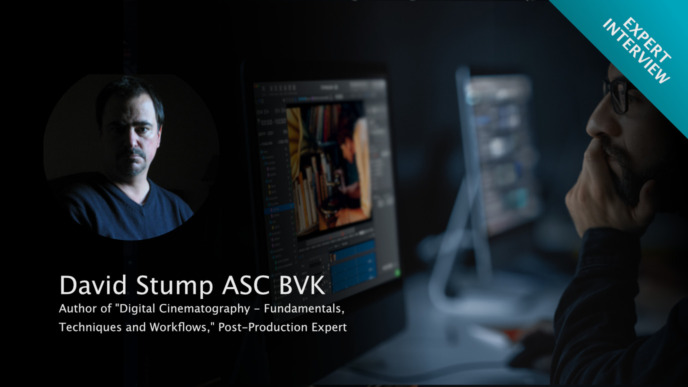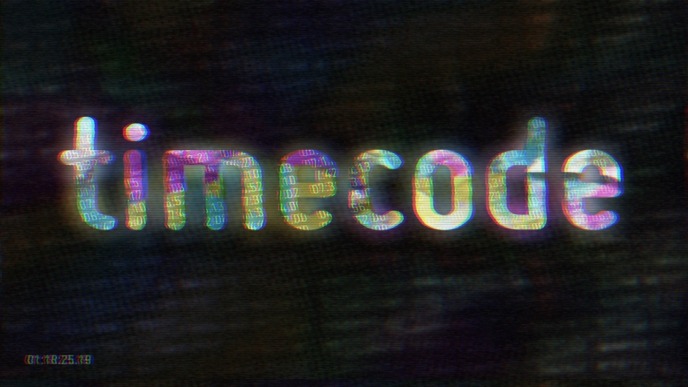
When color grading images, using controller setups to help you keep your eyes on the calibrated monitor is key. This especially holds true when grading on set, even if there is limited space compared to a suite in a post-production facility.
In this article, we’ll offer more insight into the value of leveraging Pomfort’s support of various controller devices— supported by interviews of Livegrade user Jason Naran and Silverstack user Ant Thornton, on how they use a device that was originally designed to help online gamers: Stream Deck.
To get an idea about the basics of adjusting color via controllers, let’s start with a brief history of color grading.
Using Printer Lights as a Basic Toolset
In the days of analog post-processing films— basically everything before 2000, there were few possibilities for adjusting color. With the so called ‘printer lights,’ the color timer (as the colorists where usually called back then) chose the amount of red, green, and blue lights to create the film positive. On a shot-by-shot basis, the colorist added or removed R, G, B printer points to shift individual shots in a certain direction or simply make them lighter or darker.
Even with the way more advanced digital color correction technology today, starting with printer lights for the initial image correction still absolutely makes sense. With that method, one will change color and luma values organically— just like a traditional film print process.
Color Wheels for Great, Intuitive Adjustments
With the invention of digital color grading in the last few decades, new methods and tools, like color wheels, were introduced to enable colorists to greatly alter an image in a very intuitive way.

At the highest level of color grading, advanced grading panels offer the colorist not only the famous color wheels but also countless turning knobs and buttons for basically every action one can think of. However, this setup only makes sense in one specific scenario: In a big darkened room, protected by a roof. But more often than not, conditions on a filmset are different.
Stream Deck as an Extension for a DIT Cart
To meet the challenges of a filmset, Livegrade and Silverstack support a large number of different controllers, such as all grading panels from Tangent— from small to big— or MIDI controllers that can be combined to create an intuitive, flexible and set-suitable DIT cart. One type of controller that becomes more and more popular is Elgato’s Stream Deck devices.
Stream Deck was originated as a device to help gamers easily stream their live play without taking their eyes off of the screen. While both Livegrade and Silverstack users have adopted the device to use for different purposes, the benefit of using a Stream Deck remains the same.

A Stream Deck device’s customizable buttons are automatically assigned to the different useful functions of Pomfort’s products. This allows DITs to extend their toolset and keep their eyes on the montior while they work.
Stream Deck and Livegrade
To get a better sense of how these devices really impact a DITs Livegrade workflow, and the unique customizable options, we got the chance to sit down with Livegrade user and DIT, Jason Naran.
First of all, thank you so much for doing this interview with us! Could you please tell us a little about yourself and your professional life?
Jason: My name is Jason Naran, and I’ve been working in the industry since digital cameras became the standard. I used to get called by camera teams who needed a technician that knew how to handle digital media.
Prior to that I was doing broadcast and editorial work, some presentation and multi-camera directing, plus video engineering and playback roles. Naturally I progressed into the DIT role from there.

I grew up in Wellington, New Zealand— where Peter Jackson & James Cameron also call home. Over the years I’ve been lucky to be on set for some exciting and complex projects.
What kind of projects do you usually work on? What is one project in particular where your Livegrade Pro x Stream Deck integration played a role in your workflow?
Jason: I used do a lot of feature work, but in the past few years I’ve done a lot of long form TV series. l really enjoy both formats and have different approaches for each one.
On the Avatar sequels I heavily relied on a Stream Deck for shooting 3D stereo. My Stream Deck is one of the most dependable tools on my cart. It has changed the way I work every day, and I don’t think I could shoot without it.

I used to feel that the Livegrade Pro interface required too many keyboard actions and I kept wanting to see more of the user interface. I also wanted to reduce the amount of time that I stared at my Laptop. I needed to be watching the calibrated monitors when rolling, not looking at Livegrade Pro.
By choosing a Stream Deck, this issue is completely solved. The biggest benefit of using one with Livegrade Pro is faster functions, less time spent looking at my laptop, and the ability to make adjustments on the fly without taking my eyes off screens.
We’re aware that every DIT’s colour grading control setup varies. How would you describe yours?
Jason: I think of my cart as the DP’s on-set workspace. We share the cart and DPs sit with me all day where we have plenty of dialogue about their creative intentions. I don’t see a need for them to be at a remote station as they can get all functions in one place. Every DP I’ve worked with really appreciates this set up.
I use a custom studio cart with two permanant monitors, and I add a third monitor when shooting complex scenes— like if we’re shooting outdoors and the light is changing, or when I’m match grading more than one camera.

While dealing with different types of cameras & lenses, various filters, different camera angles, constant lighting adjustments, from cloud to sun, interiors versus exteriors, with colour shifts in sensors between cameras— there is always balancing work to be done.
My approach to being a DIT is that I am providing image consistency throughout a scene, every day, and all the way through a shoot. DPs ask me to manage this and then trust me to take care of this every time, on every shot. Setting cameras, balancing for sensor differences, switching between looks & LUTs, changing filters, applying creative grades for a scene, then managing exposure, everyday. It can get pretty busy.
We want the dailies team to be able to push through all clips without needing any adjustment. What is created on set is exactly what editorial and post sees.
To learn more, could you please walk us through your controller setup?
I always use the latest version of Livegrade Pro from the beginning of a job. We don’t update during a job, unless it’s for a specific new feature.
My Stream Deck is used exclusively for Livegrade Pro, which means it works when I have Livegrade Pro running in the background. I don’t use it for other applications. It’s connected via USB to a Thunderbolt Dock, then to my Laptop. Everything works through one cable, so it’s very clean, reliable and efficient.

I own the three different sized Stream Decks, and I found one 20x button version is perfect. Not too big or busy, not too small either.
I have my buttons programmed for taking shots from separate Slots. I also have ‘Original, Bypass & Grade’ buttons. My favorite button is the ‘Increase Clip’ and ‘Increase Take’.
My team made a great trick using the multi-action feature. They made a one-button function that opened Mail, typed a message saying ‘That’s a wrap,’ and then sent it to various recipients. We almost took the next step to send to everyone on the call sheet. But instead, we turned the idea into a crew T-Shirt.

Do you have one fixed setup for live grading on set? Or does it vary depending on the job requirements?
I work from my full cart for all of my jobs, only making small adjustments or changes at the start of production. This way the DP I’m working with can rely on my routine every day.
What is your favorite part about being able to use Livegrade Pro and Stream Deck together?
I really appreciate the ability to jump between color, metadata and browser views in Livegrade Pro. I use my Stream Deck for this hundreds of times a day. I also use the ‘Increase Clip’ and ‘Increase Shot & Take’ functions all day long. My SD can get a lot of use when shooting many cameras.
Is there anything we haven’t covered that you would like to add?
I’ve been using Livegrade and Silverstack for many years now and have seen some really great developments over the years. I enjoy working as a DIT and I have developed my routine so it works for me. I look forward to learning some things from other DITs via these great Pomfort articles.
Thanks to Pomfort for allowing me to do what I do!
Thank you very much Jason for your sharing your exciting insights!
Stream Deck and Silverstack
Similar to Jason and his experience with using Stream Deck, DIT Ant Thornton integrated Stream Deck to optimize his DIT cart with Silverstack Lab. We got the chance to sit down with Ant to learn more about how he’s integrated Stream Deck and how it impacts his workflow.

First of all, thank you so much for doing this interview with us! Could you please tell us a little about yourself and your professional life?
I’m Ant Thornton, a Bristol, UK-based DIT. I started as a camera operator before moving into editing. I worked mostly on small to medium-budget music videos and live sessions with the occasional corporate gig. I spent a few years out of the industry while I pursued music. Then, when I was looking to rejoin the industry, the role of the DIT really appealed to my skill set so I haven’t looked back.

What kind of projects do you usually work on? What is one project in particular where your Silverstack Lab x Stream Deck integration played a role in your workflow?
I work on a wide variety of jobs— commercial, narrative, documentary, and television. I do a lot of multi-camera shows where I’m constantly offloading and reviewing footage. Having the ability to quickly navigate through the GUI and eliminate using the mouse as much as possible is invaluable to me.
We’re aware that every DIT’s control setup varies. How would you describe yours?
I would describe my control setup as efficient. With everything I do, I’m always looking for the cleanest and quickest way to work and I think the way in which I’ve set up my Stream Deck within Silverstack reflects that.
To learn more, could you please walk us through your controller setup?
I have my Stream Deck housed in a 3D printed caddy which I mount to my Inovativ digiplate with a small magic arm, positioned to my left.

My Stream Deck is configured into sections. For example, offload tools are in the top left, playback tools are in the bottom left, and so on. Everything is organized to speed up my workflow.

I have a home profile where I have everything I need outside of Silverstack Lab. When I am in Silverstack Lab, the profile switches to my custom Silverstack profile. As I’m currently working on a multi-camera show, the Stream Deck is geared towards having the tools I use most often for these jobs.
Do you have one fixed DIT setup on set? Or does it vary depending on the job requirements?
I have a cart which I prefer to work from, but when needed I can work out of my Inovativ 1535 digicase. Everything inside that case along with a run bag, contains anything else I might need— a small UPS, cables, tools, etc.

Last year, I worked on a TV show in London where each episode was filmed over two days— day one being at the main studio where I kept my cart setup and day two being across the city, always somewhere new like a tiny hair salon in a basement, an old theater or a brewery, etc. Situations like these are where my digicase and run bag setup really comes in handy.
What is your favorite part about being able to use Silverstack Lab and Stream Deck together?
As I previously mentioned, I work on a lot of multi-camera shows where I can manage anywhere from 3-4 cameras to 20 plus. There’s a lot of repetition involved with the workflow and the one thing that really helps me keep data moving continuously is the quick offload button which shows you the latest mounted mag. It takes a step or two out of the equation and I can have rushes offloading to multiple destinations in as little as two actions.

Is there anything we haven’t covered that you would like to add?
The role of the DIT is often misunderstood so to have a platform like this for others to share their experiences/tips and tricks is really wonderful. Thank you for everything you do for the community and for making great products.
Thank you very much Ant for your sharing your exciting insights!
Conclusion
The possibilities to optimize on-set workflows by using controllers in Livegrade and Silverstack are endless: while grading panels and dials mainly support the process of color grading, highly customizable Stream Deck devices help to speed up daily routines and significantly reduce individual manual steps for several other DIT workflows.
Our latest addition is the integration of Stream Deck+ with Livegrade Pro/Studio, which provides even more possibilities with the addition of configurable dials. Printer lights and simple grading parameters can now be adjusted intuitively, precisely and quickly, by just turning the knob.
In the end what matters most is that you are able to map a wide variety of workflows while ensuring intuitive and efficient work practices.
So, what are your favorite controllers when it comes to color grading, look- or asset-management on a film-set? Let us know— we are eager to hear your stories!
What Is New in Livegrade Studio?
Check out all new features and highlights of the latest release.



